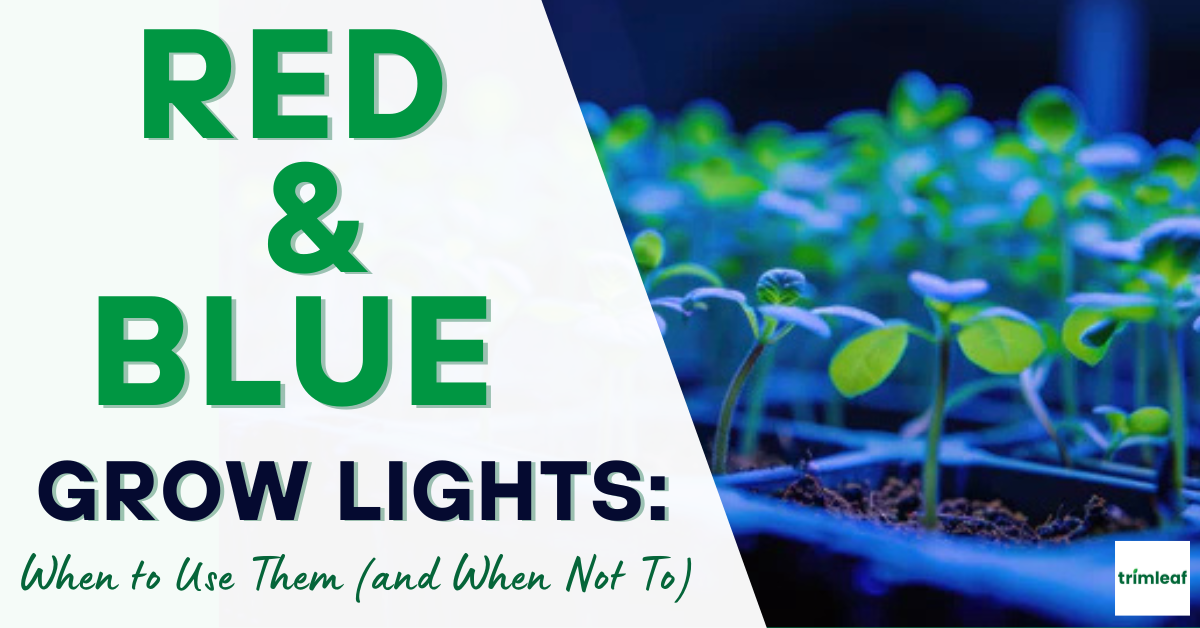
Walk into any indoor grow and you’ll spot them right away — panels glowing that unmistakable purple from their red and blue diodes. These LED grow lights have become a staple in indoor gardening, marketed as efficient, affordable, and perfect for plant growth.
But here’s the big question: Are red and blue grow lights really the best choice for every grow?
The short answer: not always. While red and blue wavelengths are essential for photosynthesis, relying on them alone can lead to issues like leggy stems, weak yields, or plants that don’t develop the color, aroma, or structure you’re hoping for.
Table of Contents
- Why Red and Blue Light Matter for Plant Growth
- Red and Blue Plus Other Spectrum Additions
- Benefits of Red and Blue Grow Lights
- When to Use Red and Blue Lights?
- When NOT to Use Red and Blue Lights
- Red and Blue vs. Full Spectrum Grow Lights
- How to Balance Your Spectrum
- Common Mistakes with Red and Blue Lights
- Conclusion
- Frequently Asked Questions About Red and Blue Grow Lights
Why Red and Blue Light Matter for Plant Growth

Plants use light for photosynthesis, but not all wavelengths are equal. Two regions of the light spectrum play especially important roles:
Blue Light (400–500 nm)
- Encourages chlorophyll production
- Promotes sturdy stems and compact growth
- Essential in early growth as it keeps plants short and strong instead of leggy.
Red Light (600–700 nm)
- Signals flowering and fruiting
- Stimulates phytochrome responses
- Helps plants stretch taller and redirect energy toward flowers, buds, and fruit
Switching from a cheap red-blue lamp to a full-spectrum fixture with extra red diodes made a huge difference — flowers became denser, and the smell (terpene profile) was noticeably stronger.
Red and Blue Plus Other Spectrum Additions
Red and blue may be the backbone of plant growth, but modern lighting has shown that other parts of the spectrum also play important roles.

-
Far-Red Light (700–750 nm)
Far-red influences flowering responses and can trigger plants to stretch slightly, which is useful in fruiting crops. It’s especially valuable in the transition from vegetative to bloom. -
UV Light (280–400 nm)
Small amounts of UV stress plants just enough to boost trichome and resin production. This can mean better flavor, aroma, and potency in cannabis and other aromatic plants. -
Green Light (500–600 nm)
Once thought to be wasted, green light penetrates deeper into the canopy than red or blue. This means it helps lower leaves photosynthesize, leading to more even plant growth.
The best grow setups don’t see red and blue as “the whole picture.” Instead, they treat them as key players in a broader spectrum strategy that includes far-red, UV, and green for optimal yield and plant quality.
Benefits of Red and Blue Grow Lights
Even with modern full-spectrum LEDs dominating the market, red and blue grow lights continue to offer practical advantages. Their biggest selling point is efficiency — most of the light they emit falls right within the wavelengths plants use for photosynthesis, which means very little energy goes to waste.
They also consume less power compared to HID lamps or broad-spectrum setups, making them a smart choice for growers watching electricity costs. On top of that, they’re budget-friendly and versatile, making them a solid option for small-scale or beginner indoor gardens.
Key Benefits
- High Efficiency: Nearly all emitted light is absorbed by plants for photosynthesis.
- Lower Power Consumption: Uses less electricity than HID lamps or broad-spectrum LEDs.
- Cost-Effective: Affordable entry point for new growers or small indoor gardens.
- Targeted Growth Control: Adjusting red and blue ratios fine-tunes vegetative growth or flowering.
- Compact Design: Perfect for micro-gardens, seedlings on a shelf, or countertop herb gardens.
When to Use Red and Blue Lights?
Red and blue lights are most effective when they’re used with purpose rather than as a one-size-fits-all solution.

During the earliest stages — seedlings and clones — a blue-heavy spectrum helps prevent stretching and builds strong stems. As plants move into vegetative growth, keeping more blue than red in the mix encourages compact leaf development, giving growers stocky, healthy plants.
When the cycle shifts to flowering and fruiting, increasing red light, sometimes up to a 4:1 red-to-blue ratio, promotes strong bud development and fruit set. These lights also work well as supplemental tools in greenhouses, where they can compensate on cloudy days by boosting photosynthesis without the need to flood plants with full-spectrum light.
For budget indoor setups, especially when a grower is just starting out, a red and blue panel can serve as an affordable bridge before investing in a full-spectrum fixture.
When NOT to Use Red and Blue Lights
Red/blue LEDs can help, but avoid these scenarios to protect yield and quality.
Using them as your only light
Plants may grow, but color, aroma, terpene content, and nutrient density usually trail full-spectrum results.
Decorative/houseplant displays
Purple light makes plants look unnatural. If aesthetics matter, use a full-spectrum or white LED.
Health checks under purple light
Pests and deficiencies are hard to see. Inspect plants under white light to spot issues early.
Unbalanced red/blue ratios
Too much red → leggy, weak stems.
Too much blue → squat, slow growth. Balance per stage.
Red and Blue vs. Full Spectrum Grow Lights
For many growers, the comparison between red-blue panels and full-spectrum LEDs is what determines long-term choices.
Full-spectrum fixtures cover not only red and blue but also green, far-red, and sometimes even UV. This broader coverage doesn’t just fuel photosynthesis — it improves plant quality by enhancing aroma, flavor, and potency. Red and blue LEDs, on the other hand, are more narrowly focused. They deliver the most “efficient” wavelengths but often sacrifice the nuanced benefits that come from exposing plants to a wider range of light.
The best practice for most indoor gardens is to use full-spectrum LEDs as the primary grow light. Red and blue panels can then be applied strategically as supplemental boosters, whether that’s in a greenhouse to extend light hours or during the flowering stage to push bud production a little further.
How to Balance Your Spectrum
Vegetative Stage
A balance of 1:1 to 2:1 blue-to-red is ideal. The stronger presence of blue keeps plants compact, encourages dense leaf growth, and helps stems grow sturdy enough to support future flowers.
Flowering Stage
As plants enter bloom, they need more red. A 3:1 to 4:1 red-to-blue ratio stimulates budding and fruit production, driving yields higher while still keeping enough blue to prevent overstretching.
For example, in a 3×3 grow tent using a 300W red-blue LED panel, you might keep the light hung higher and adjusted toward blue during the veg stage. Once plants begin flowering, lower the fixture slightly and emphasize red output. Always check the manufacturer’s PPFD maps to avoid light burn and ensure even coverage across the canopy.
💡 Advanced Tip
Growers with a larger budget can benefit from tunable or dimmable LEDs. These fixtures let you fine-tune the red-to-blue ratio throughout the entire cycle, removing the need to swap lights and giving you more control over each stage of growth.
Common Mistakes with Red and Blue Lights
While red and blue LEDs can deliver great results, many growers run into problems by overlooking the basics. Here are the most common mistakes to avoid:

Hanging too close
Lights that sit too close to the canopy can cause bleaching or “light burn.” Always check the manufacturer’s recommended distance and adjust as plants grow.
Using the wrong ratios at the wrong stage
Plants need more blue early and more red later. Sticking with a single ratio throughout the cycle often leads to weak stems, stretching, or poor flower set.
Skipping white light checks
Under purple light, pests and nutrient deficiencies are nearly invisible. Always inspect plants under white light to catch problems before they spread.
Assuming purple equals better
Many beginners think more purple glow means stronger growth. In reality, spectrum balance matters more than sheer intensity of red and blue.
Conclusion
Red and blue grow lights aren’t going anywhere — they remain a useful, affordable option for growers who want to target specific growth stages or supplement natural light. Blue light builds sturdy stems and compact plants, while red light drives flowering and fruit production. But as a sole light source, they fall short compared to modern full-spectrum LEDs, which provide a more balanced spectrum for higher quality yields and healthier plants.
The best approach for most indoor gardeners is to use full-spectrum LEDs as the main fixture and treat red-blue panels as supplemental tools. This way, you get the efficiency and targeted benefits of red and blue without sacrificing the overall plant health, appearance, or yield that comes from a broader spectrum.
Frequently Asked Questions About Red and Blue Grow Lights
- Are red and blue grow lights good for all plants?
-
They work well for most edible plants and herbs, but ornamental or display houseplants often look unnatural under purple light. For those, full-spectrum LEDs are better.
- What’s the best red-to-blue ratio for vegetative growth?
-
A 1:1 to 2:1 blue-to-red ratio keeps plants compact, strengthens stems, and prevents stretching.
- Do plants grow faster under red light?
-
Red accelerates flowering and fruiting, but too much red alone can cause leggy growth. Balance it with blue for best results.
- Can I flower plants under only blue light?
-
Blue encourages leafy, compact growth but won’t drive strong flowering. Add red to support bud and fruit development.
- Why do my plants look strange under purple light?
-
The red/blue mix masks true colors, making it hard to judge plant health. Inspect under white light to spot pests or deficiencies.
- Do red and blue grow lights increase yield?
-
They can, when used at the right stage (more red in flower). Overall quality and yield are usually higher with a full-spectrum base light.
- Can I mix red-blue lights with regular LEDs?
-
Yes. Many growers run a full-spectrum LED as the main fixture and add red/blue panels as supplemental lighting, especially in bloom.
- How close should red and blue lights be to plants?
-
About 18–24 inches in veg and 12–18 inches in flower. Check the PPFD map from the manufacturer to avoid bleaching.
- Are red and blue grow lights energy-efficient?
-
Yes. They target wavelengths plants use most for photosynthesis, making them more efficient than older HID or fluorescent lamps.
- Are full-spectrum LEDs better than red/blue panels?
-
For most growers, yes. Full spectrum supports overall plant health, color, aroma, and yield. Red/blue panels still work well as affordable or supplemental options.




